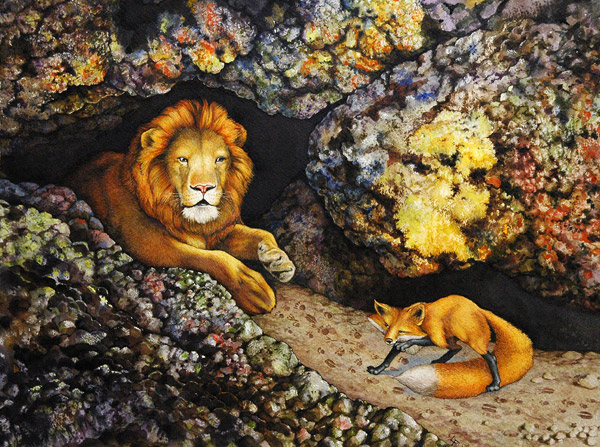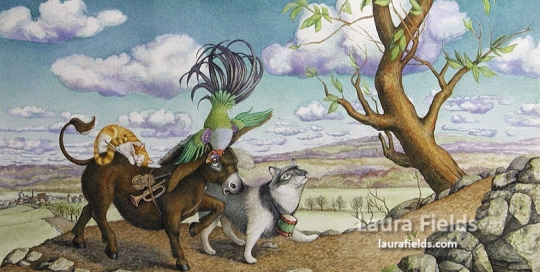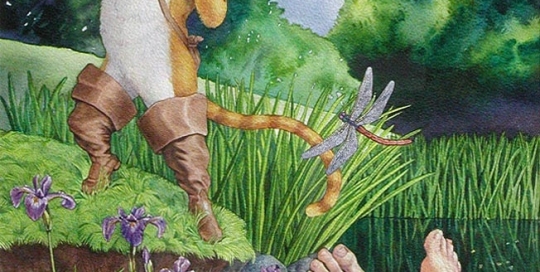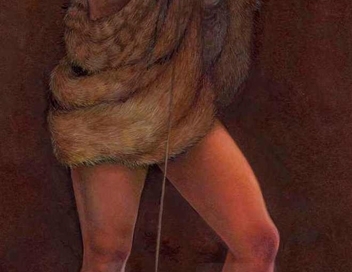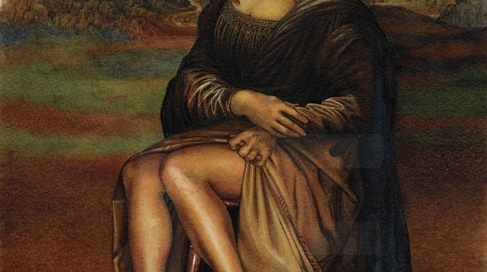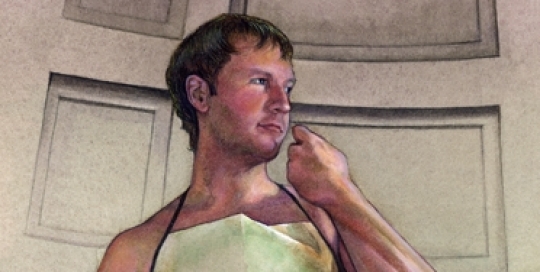St John the Baptist Wore Fake Crocs
Classic Footwear, Illustrations, Watercolors
hen Leonardo died his possessions were pitifully few. He had three of his paintings, the Mona Lisa, the Virgin and St. Anne and his final painting, that of St. John the Baptist. This painting dates from his final years in Rome, around 1509-1516.
Many people are critical of this work by DaVinci, finding it a disturbing representation of a character normally portrayed as gaunt and fiery, living in a desert and surviving on a diet of locusts and honey. In Leonardo’s painting St. John seems almost to be a hermaphrodite. He has a womanish arm bent across his breast, his finger raised towards heaven, and that same enigmatic smile so admired on the face of Mona Lisa, a smile which can be seen in other Leonardo paintings like that of St. Anne. His face is almost faun-like and framed by a glorious cascade of curls. The finger pointed towards heaven was to appear quite often in Leonardo’s work (the Burlington House cartoon is another example) and denotes the coming of Christ.
I first saw this painting when I visited the Louvre, in Paris. It hung near the Madonna of the Rocks, another of my DaVinci favorites, and was nearly impossible to get a good look at. The painting is so dark that making out detail was very difficult. But even with the glare on the protective glass, the glossy oil, and the dark, possibly dirty painting surface, John the Baptist’s gaze was captivating and impossible to ignore. The standard portrayal of John the Baptist as an older man with fur hides wrapped around him and a heavy wooden walking stick was absent here. This was a young androgynous man, with beautiful ringlets in his hair and a […]
You’d Smile Too…
Classic Footwear, Illustrations, Watercolors
he Mona Lisa (La Gioconda or La Joconde, or Portrait of Lisa Gherardini, wife of Francesco del Giocondo) is a half-length portrait of a woman by the Italian artist Leonardo da Vinci, which has been acclaimed as “the best known, the most visited, the most written about, the most sung about, the most parodied work of art in the world.”
That perfect moment of seeing the Mona Lisa’s enigmatic smile for the first time was awe-inspring for me. The perfection of her taut skin, the beautiful details on her bodice, the sheer veil over her parted hair…it was all overwhelmingly fascinating to me. She has become such a common sight to most modern eyes, but her beauty could not be paled by her familiarity. Even being forced to stand at least 15 feet from the painting and having to force my way through the crowd to get a closer look at her from all angles, I loved the sight of her. La Joconde is still my favorite painting.
I recreated DaVinci’s painting entirely in watercolor. The paint was applied in thin transparent layers to create depth of color. Although the sky is much greener than the original, it was done purposefully to stress the red of her shoes. She is one of four paintings in my “shoe series.” Now we can all know what’s been on her on her mind for 500 years. The examination of her enigmatic smile has come to an end…
Watercolor on Windsor Newton Cold Press (signed and numbered prints available)
Michelangelo’s David O’Brien
Illustrations, Watercolors
avid is a masterpiece of Renaissance sculpture created between 1501 and 1504, by the Italian artist Michelangelo. The marble statue of a standing male nude is a favored subject in the art of Florence. Since its unveiling in 1504, David has become an iconic statue, instantly recognized around the world and attracting millions of tourists every year.
I will never forget my visit to the Academia in Florence, Italy, where Michelangelo’s David stands upon his marble base. The image of his physique and the indelible mark that Michelangelo’s skills have left upon me will never fade. What struck me on my visit to Italy, whether it be Rome, Florence, Venice, or any other city, was the incredibly odd nature of the tourist trade. The country’s priceless statues and works of art have been re-imagined in the most ludicrous ways. The Trevi Fountain is sold as pencil sharpener or a beach towel. The Sistine Chapel is printed on a shower curtain or The Laocoon is for sale as an umbrella stand. And not to be outdone, the David statue, in Florence, can be bought as an image on an apron with the Italian colors behind him. I could not resist the absurdity and created my own image with David’s likeness. The Irish tourist, in the flesh, would pose in the exact posture as Michelangelo’s David wearing the apron. He would appear nude, but would not actually expose himself to the viewer by means of the apron. No man could hope to equal the grace and perfection of the actual statue, anyway, in my opinion…
Watercolor on Windsor Newton cold press (signed and numbered prints available)

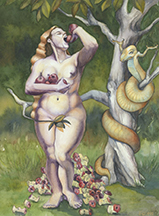


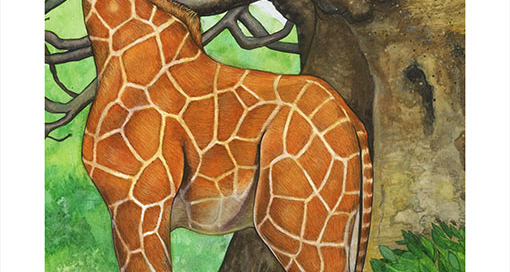
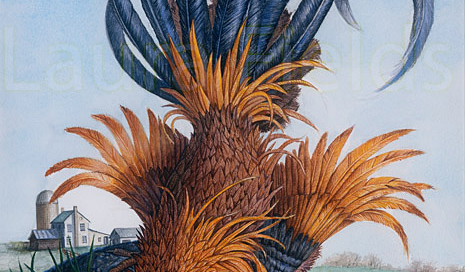
 The painting is purely watercolor painted with both wet and “drybrush” technique. It is one half of a diptych, the other being Aesop’s Lion and the Mouse. The two are meant to hang vertically with the Rooster on the left and the Lion on the right. The color schemes are purposefully linked.
The painting is purely watercolor painted with both wet and “drybrush” technique. It is one half of a diptych, the other being Aesop’s Lion and the Mouse. The two are meant to hang vertically with the Rooster on the left and the Lion on the right. The color schemes are purposefully linked.